

Dysgraphia Accommodations and Modifications. By: Susan Jones (1999) Many students struggle to produce neat, expressive written work, whether or not they have accompanying physical or cognitive difficulties.
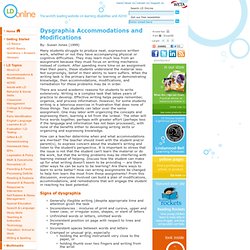
They may learn much less from an assignment because they must focus on writing mechanics instead of content. After spending more time on an assignment than their peers, these students understand the material less. Not surprisingly, belief in their ability to learn suffers. Accommodations & Modifications ... Dysgraphia.
Interventions for Dysgraphia. Jones, S. 2e Newsletter May/June 2011 In this article, Susan Jones provides advice on how to accommodate for the needs of students with dysgraphia.

Adapted from Dysgraphia Accommodations and Modifications by Susan Jones (1999) Two students can labor over the same assignment. One may labor with organizing the concepts and expressing them, learning a lot from the “ordeal.” The other will force words together, perhaps with greater effort (perhaps less if the language and information have not been processed), with none of the benefits either to developing writing skills or organizing and expressing knowledge. Writing Disability. Dysgraphia is a learning disability that affects writing, which requires a complex set of motor and information processing skills.
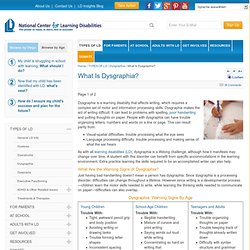
Dysgraphia makes the act of writing difficult. It can lead to problems with spelling, poor handwriting and putting thoughts on paper. The Importance of Teaching Handwriting. After a long period of neglect in education, attention to teaching handwriting in the primary grades may finally be returning.
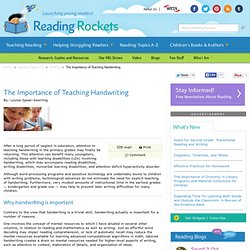
This attention can benefit many youngsters, including those with learning disabilities (LDs) involving handwriting, which may accompany reading disabilities, writing disabilities, nonverbal learning disabilities, and attention deficit hyperactivity disorder. Although word-processing programs and assistive technology are undeniably boons to children with writing problems, technological advances do not eliminate the need for explicit teaching of handwriting.
Understanding_Dysgraphia_Fact_Sheet_12-01-08. Strategies for the Reluctant Writer. By: Regina G.
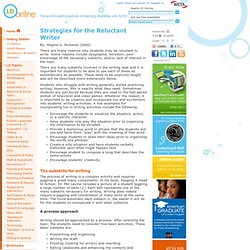
Richards (2002) There are many reasons why students may be reluctant to write. Some reasons include dysgraphia, boredom, poor knowledge of the necessary subskills, and/or lack of interest in the topic. Strategies for Dealing with Dysgraphia. By: Regina G.

Richards A common teaching technique is to have the students write information to reinforce the material. For example, spelling programs often encourage students to write each spelling word five times or 20 times. All Resources. Mathematics Disability. Students struggling with math may have a neurocognitive disorder called dyscalculia: Disorder affects roughly as many people as dyslexia.
Students who struggle to learn mathematics may have a neurocognitive disorder that inhibits the acquisition of basic numerical and arithmetic concepts, according to a new paper.
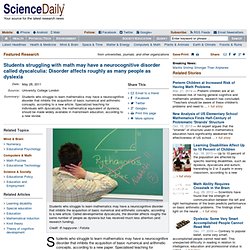
Specialised teaching for individuals with dyscalculia, the mathematical equivalent of dyslexia, should be made widely available in mainstream education, according to a review of current research published in the journal Science. Students struggling with math may have a neurocognitive disorder called dyscalculia: Disorder affects roughly as many people as dyslexia. Dyscalculia: Number games. Brian Butterworth hopes that his number games will help dyscalculic children — and open a window on how the brain processes numbers.
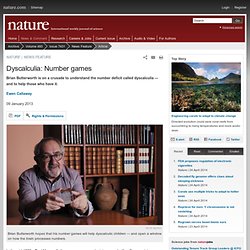
In the mid-1980s, Paul Moorcraft, then a war correspondent, journeyed with a film crew into Afghanistan to produce a documentary about the fifth anniversary of the Soviet invasion. The trip took them behind Soviet lines. Dyscalculia: Number games. Dyscalculia - Numberphile. Mathematics Disability. Mathematics Disability. Dyslexia. Free Apps for Kids. Our Free Apps For Kids page is a listing and review of some of our favorite literacy apps available to help children learn essential early literacy skills.
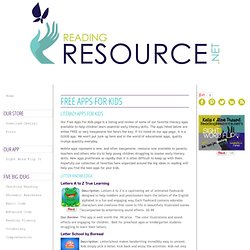
The apps listed below are either FREE or very inexpensive but here's the key: If it's listed on our app page, it is a GOOD app. We won't put junk up here and in the world of educational apps, quality trumps quantity everyday. Mobile apps represent a new, and often inexpensive, resource now available to parents, teachers and others who try to help young children struggling to master early literacy skills. Helping dyslexic children within the classroom. © 2000, Patricia Hodge Dip.spld(dyslexia) Proficient reading is an essential tool for learning a large part of the subject matter taught at school.
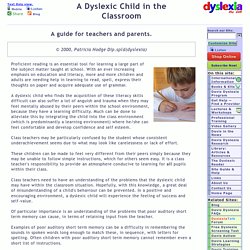
With an ever increasing emphasis on education and literacy, more and more children and adults are needing help in learning to read, spell, express their thoughts on paper and acquire adequate use of grammar. A dyslexic child who finds the acquisition of these literacy skills difficult can also suffer a lot of anguish and trauma when they may feel mentally abused by their peers within the school environment, because they have a learning difficulty.
Much can be done to alleviate this by integrating the child into the class environment (which is predominantly a learning environment) where he/she can feel comfortable and develop confidence and self esteem. Class teachers may be particularly confused by the student whose consistent underachievement seems due to what may look like carelessness or lack of effort. Strategies for Teaching Reading Comprehension. Upon completion of this section, you will: Understand the components of reading comprehension Receive ideas for making the text personally relevant Learn how to teach active engagement with the text Obtain extension activities for all learning styles Traditionally, reading comprehension was narrowly thought to encompass answering multiple-choice questions after reading a story or passage.
Classroom Strategies: Creating a Reading Culture for Struggling Readers. Then I stumbled upon a simple observation that gave me an idea—and lots of hope. It all started when I hired a colleague of mine, Meg, to work with my dyslexic son on his writing the summer before he entered high school. Like any good writing teacher, his summer tutor understood the intimate connection between reading and writing. The 19 Learning Dysfunctions. The 19 Learning Dysfunctions 1. Motor Symbol Sequencing This capacity is involved in the process of learning and consistently producing a symbolic sequential motor pattern (e.g., writing out the alphabet, or numbers).
All sequential symbolic processes involving input through the eye (e.g., reading), output through the hand (e.g., writing) and mouth (e.g., speaking) are impaired when there is a weakness in this capacity. Dyslexia Simulation. You are here: Home > Simulations > Dyslexia Simulation Instructions This simulation demonstrates some common symptoms of dyslexia. You are given 60 seconds to read a paragraph aloud. The letters in this paragraph are reversed, inverted, transposed, and spelling is inconsistent. Dyslexia Simulation #2. Dyslexia for a Day- Writing SimulationH.264 800Kbps.mov.